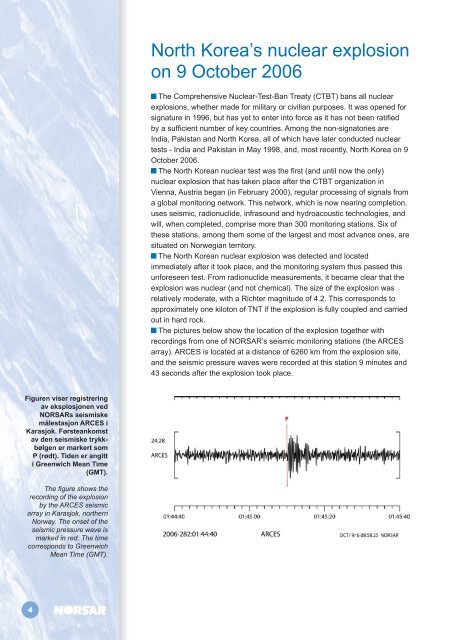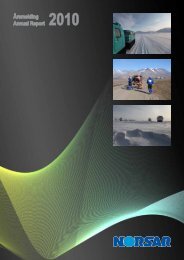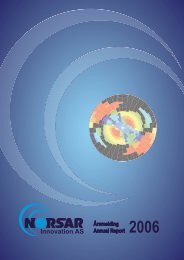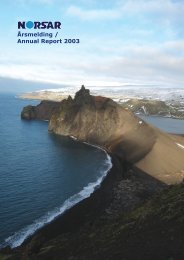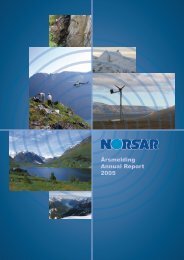Lectures - Norsar
Lectures - Norsar
Lectures - Norsar
You also want an ePaper? Increase the reach of your titles
YUMPU automatically turns print PDFs into web optimized ePapers that Google loves.
Figuren viser registrering<br />
av eksplosjonen ved<br />
NORSARs seismiske<br />
målestasjon ARCES i<br />
Karasjok. Førsteankomst<br />
av den seismiske trykkbølgen<br />
er markert som<br />
P (rødt). Tiden er angitt<br />
i Greenwich Mean Time<br />
(GMT).<br />
The figure shows the<br />
recording of the explosion<br />
by the ARCES seismic<br />
array in Karasjok, northern<br />
Norway. The onset of the<br />
seismic pressure wave is<br />
marked in red. The time<br />
corresponds to Greenwich<br />
Mean Time (GMT).<br />
North Korea’s nuclear explosion<br />
on 9 October 2006<br />
The Comprehensive Nuclear-Test-Ban Treaty (CTBT) bans all nuclear<br />
explosions, whether made for military or civilian purposes. It was opened for<br />
signature in 1996, but has yet to enter into force as it has not been ratified<br />
by a sufficient number of key countries. Among the non-signatories are<br />
India, Pakistan and North Korea, all of which have later conducted nuclear<br />
tests - India and Pakistan in May 1998, and, most recently, North Korea on 9<br />
October 2006.<br />
The North Korean nuclear test was the first (and until now the only)<br />
nuclear explosion that has taken place after the CTBT organization in<br />
Vienna, Austria began (in February 2000), regular processing of signals from<br />
a global monitoring network. This network, which is now nearing completion,<br />
uses seismic, radionuclide, infrasound and hydroacoustic technologies, and<br />
will, when completed, comprise more than 300 monitoring stations. Six of<br />
these stations, among them some of the largest and most advance ones, are<br />
situated on Norwegian territory.<br />
The North Korean nuclear explosion was detected and located<br />
immediately after it took place, and the monitoring system thus passed this<br />
unforeseen test. From radionuclide measurements, it became clear that the<br />
explosion was nuclear (and not chemical). The size of the explosion was<br />
relatively moderate, with a Richter magnitude of 4.2. This corresponds to<br />
approximately one kiloton of TNT if the explosion is fully coupled and carried<br />
out in hard rock.<br />
The pictures below show the location of the explosion together with<br />
recordings from one of NORSAR’s seismic monitoring stations (the ARCES<br />
array). ARCES is located at a distance of 6260 km from the explosion site,<br />
and the seismic pressure waves were recorded at this station 9 minutes and<br />
43 seconds after the explosion took place.


